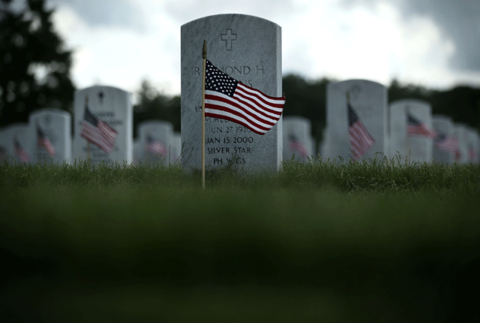Memorial Day, The Troops, and The F-35

Another Memorial Day has come and gone, and I'm feeling a bit more melancholic than usual. That's for a number of reasons, including an old one: The F-35 Joint Strike Fighter. It appears that many of the things I was very much afraid of happening are coming to pass as a result of the F-35's bloated impact on the defense budget. And this means one thing. The troops are taking it on the chin.
Don't believe me? Several seemingly unrelated news items are demonstrating quite clearly the cracks in the thin facade of U.S. military might. First comes the news that the U.S. Army's performance at the 2016 Strong Europe Tank Challenge was less than desired. Designed to test combat skills and training the Strong Europe Tank Challenge featured six nation's battling to see who had the best team. Sadly for the U.S. Arny the Germans ran away with first place. Competing in their Leopard 2A6 main battle tanks the Germans ran circles around the the American team. And if that weren't bad enough so did the Danes, who took second, and the Poles, who took third place.This was a competition that tested unit skill and quality, not equipment. And the U.S. Army came up lacking.
The second news item I want to highlight involves the U.S. Navy. Late last week came the news that the U.S. Navy is facing a nearly one billion dollar shortfall in its current operations and maintenance accounts. These would be the parts of the Naval budget that, similarly to the Strong Europe Tank Challenge, demonstrate whether or not the Navy's ships, aircraft, and sailors are maintaining unit quality sufficient that they are ready for combat. It's so bad that the Navy is being forced to, among other things, restrict Carrier Air Wing flying hours. For those of you not paying attention one of the keys to success in modern aerial warfare (and this has been true since at least World War II) is pilot training. Assuming relatively equally capable combat aircraft deployed by opposing forces pilot training is crucial to success.
To make things worse, it appears that the U.S. Navy is at it's lowest readiness point in years. To wit "Capt. Randy Stearns, commodore of Strike Fighter Wing Atlantic, said one in four aircraft were usually deployed and noted there were extreme issues with older F/A-18 Hornet strike fighters and CH-53 helicopters. Non-deploying aircraft were regularly being robbed of parts to keep deployed planes flying, he said, with the result that the fleet had little surge capacity should more aircraft be needed in action." Now, Capt. Stearns, is politically astute enough to lay blame for such conditions at the feet of sequestration, and not certain aquisitions decisions. However, the sequester had far less of an impact on the defense budget than previously thought.
And for a third news item let's go to the U.S. Marines. It appears that "out of 276 F/A-18 Hornet strike fighters in the Marine Corps inventory, only about 30% are ready to fly, according to statistics provided by the Corps. Similarly, only 42 of 147 heavy-lift CH-53E Super Stallion helicopters are airworthy." Numerous officers are quoted as blaming the sequester and overall budget cuts. And yet the Marines have been spending billions each year on buying brand new Osprey's and F-35's, but not spare parts for the aircraft they have. Meanwhile the Marine pilots are spending only four hours a month in the air, when they used to be flying upwards of 25 to 30.
On top of that a new study finds that the Marine Corps officer pool is in shocking decline as measured against Marine Corps officers thirty years ago. Of course the Marine Corps had no problem declaring the F-35 combat operational either in spite of all evidence to the contrary. But leaving aside the competence of the Marine Corps leadership could shortfalls in Marine Corps training actually be due to budget cuts when the U.S. Military as a whole is still getting well over $560 billion per year in direct funding, and nearly three quarters of a trillion dollars per year when you throw in funding for nuclear weapons, and the wars in Afghanistan, Iraq, Libya, Syria and so on....Or is something else going on? To answer that question let's look at the U.S. Air Force.
It appears that earlier this year the Air Force leadership has finally been able to kill off the A-10 in spite of vociferous opposition from it's supporters. The Air Force brass has ostensibly been pushing for this decision under the specious grounds that the F-35 is designed in part to be a CAS fighter-bomber. Leaving aside the merits of this position, if that's true why did the Air Force just commission a study to find a new replacement for the A-10 if in fact the F-35 was capable of being exactly that? And I'm letting the Air Force off easy here, as it's perhaps the poster child for bad procurement decisions.
As the F-35 continues on it's way as the most expensive weapons program in history, our fighter pilots see training hours cut and tank crewmen lose out to countries like Denmark and Poland in competitions, all while the Marine's can barely put 90 out of 276 F/A-18 Hornet's into the air. Taken in combination you can see the reason why this Memorial Day was a pensive one for this writer. One can spend hours arguing the merits of the aircraft, but there is no argument that as the F-35 program continues to ramp up the troops are being shortchanged in the basic training, and equipment maintenance that are the hallmarks of a combat ready force. The last time that happened it was the U.S. service member that had to climb a bloody and steep learning curve against German and Japanese war machines playing for keeps.



Post new comment